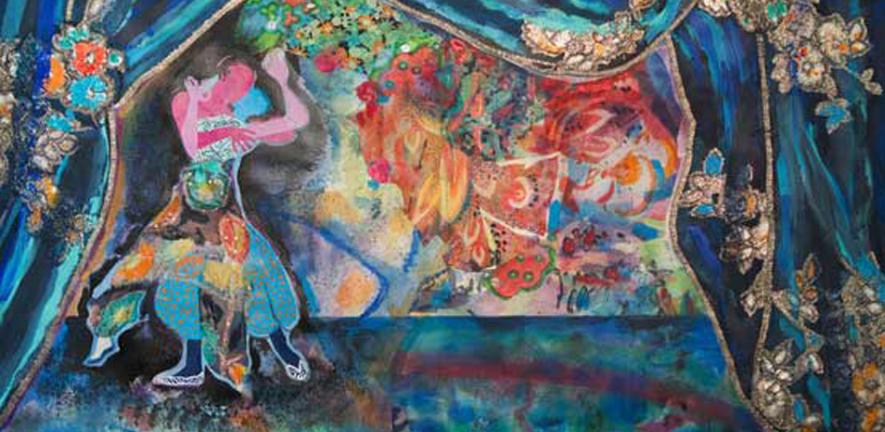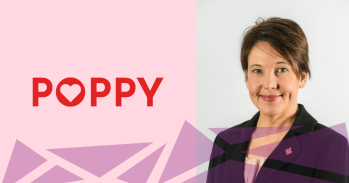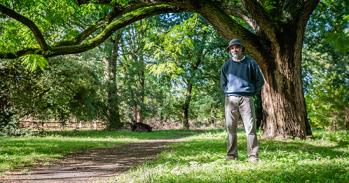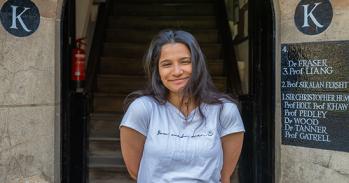
The New Hall Art Collection is Europe’s foremost collection of art by women. Don’t miss the chance to book for a free guided tour of the Collection on Friday, 7 September as part of Open Cambridge.
The New Hall Art Collection is Europe’s foremost collection of art by women. Don’t miss the chance to book for a free guided tour of the Collection on Friday, 7 September as part of Open Cambridge.
When we’re taking people round the collection, we’re often asked: is this work all by women?
Sarah Greaves, New Hall Art Collection
Sometime in 1992, two women sat down in Cambridge to write a list of 100 female artists. Dr Valerie Pearl was president of New Hall (renamed Murray Edwards College in 2008) and Ann Jones (now curator of the Arts Council Collection) was connected to the college as the wife of a Fellow. Once their list had been compiled, they sent a letter to all 100 artists to ask for donations of works of art for a collection of women’s art. Much to their delight, 75 of the 100 artists replied and, with the slimmest of funds, Dr Pearl and Ann Jones set about laying the foundations for what is now Europe’s foremost collection of women’s art and the second in the world .
As part of Open Cambridge, New Hall Collection art administrator, Sarah Greaves, is leading two free public tours of the collection on Friday 7 September. From its early beginnings, the Collection has developed to encompass more than 350 works, ranging from painting to sculpture. The Collection is not a gallery; the work is spread around Murray Edwards, enriching the surroundings for all those who work there, opening windows on to real and imagined worlds. The emphasis of the Collection is largely on the latter part of the 20th century up to the present day, with a particular strength rooted in the 1980s reflecting its origins.
Murray Edwards is an all-female college, founded in 1954, that emerged from the efforts of a small group of women determined to boost the number of women able to study at Cambridge. For the first decade it was located in what is now Darwin College and members of the Darwin family donated their family home, The Orchard, to New Hall (the name was seen as temporary) so that it had a permanent site and work began on the present buildings on Huntingdon Road in 1964, an era that favoured clean lines and simplicity of shape.
There is nothing overtly political, or feminist, about the ethos of the New Hall Art Collection established several decades later, though some of the artists represented in it certainly explore both these and other territories from a gendered point of view. The artist Miriam Schapiro, for example, used paint, collage and fabric to create pieces, referencing traditional female techniques such as applique, that she called ‘femmages’. Schapiro was active in the 1970s Feminist movement and with Judy Chicago established the Feminist Art Programme at the California Institute of the Arts.
Rather, the Collection showcases the diversity of art produced by women as makers and creators, from the uncompromising honesty of paintings by Maggi Hambling and Lucy Jones, to the scaled-up wonder in nature encapsulated by sculptor Wendy Taylor’s giant dung beetles. “When we’re taking people round the collection, we’re often asked: is this work all by women? I think their response shows just how incredibly varied the work is and that it has the power to shatter perceptions that there is such a thing as women’s art,” says Sarah.
Designated a Grade II listed building, with its iconic wide and curvy entrance, chalk-white dome and use of water to add light and energy, New Hall was designed by architects Chamberlin, Powell and Bon, who went on to design London’s Barbican Centre. “When people arrive at Murray Edwards, they see a building that contrasts strikingly with the historic college buildings of the city centre. They take a while to adjust to the 1960s architecture which is often perceived as cool and stark at first glance,” says Sarah. “The architects created a series of wonderful light spaces that lend themselves brilliantly to art works from the same era and beyond. By the time people leave, they are talking about how much they love the feel of the place,” says Sarah.
The corner stone of the Collection in terms of its development are three pairs of screen prints by Mary Kelly, which are part of a bigger series, titled Extase, which looks at women’s experience of middle age. These works, which juxtapose images of women’s clothing with extracts from women’s conversations about their lives, were produced by Kelly while artist-in-resident at Kettle’s Yard, Cambridge. The development of New Hall itself is commemorated in Maggi Hambling portraits of past presidents, Dr Pearl and Mrs Anne Lonsdale - and its 50th anniversary is celebrated by a group portrait by the photo-realist Anna Wimbledon of a group of former students.
Many of the artists represented in the Collection are extremely well known, among them the sculptors Barbara Hepworth (whose bronze work, Ascending Form, stands in Orchard Court) and Dame Elizabeth Frink (known for her masterful studies of people and animals), as well as the painter Mary Fedden (whose naïve style captures the quirky charm of objects and landscapes). Pioneers whose work is featured include Sandra Blow, whose stunning abstract painting Split Second (1991) hangs in the Fellows’ Drawing Room, and Paula Rego, whose fantastical Encampment is one of a series inspired by the blend of magic and grotesque found in fairy tales. The New Hall Art Collection continues to grow year on year. Recent additions include Scottish artist Rowena Comrie’s breathtakingly elemental Capsize, which comprises bold pools of overlapping colour. Inspired by the artist’s experience of learning to sail, it captures the exhilaration of total immersion in sea and sky, wind and weather.
New Hall Art Collection also plays host to a programme of temporary one-woman shows. Currently showing are Alex Rotas’s Veteran Athletes, an exhibition of photographs of older sports people that challenges stereotypes (closes 2 September), and painter Carolyn Blake’s Not So Happy, Yet Much Happier, a study of childhood’s remembered moments (closing 7 September). Opening on 9 September is New Morning 2010-2012, an exhibition of painting by Roberta Booth, a painter known for her lyrical treatment of myth and symbol.
To book a place on a tour of the New Hall Art Collection on Friday 7 September go to /open-cambridge or phone 01223 766766.
This work is licensed under a Creative Commons Licence. If you use this content on your site please link back to this page.





